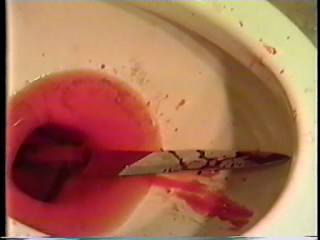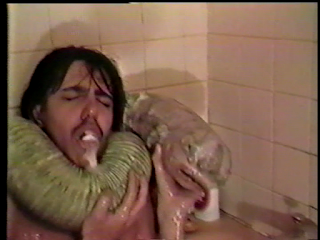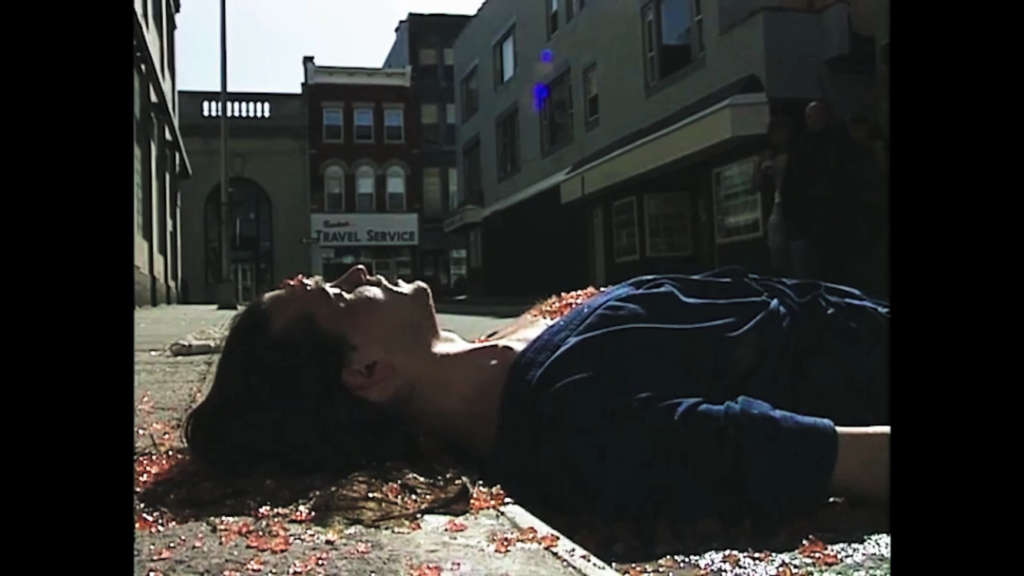‘Hallucinations’ and ‘Shatter Dead’: A Shot-On-Video Queer Double Feature [New Queer Extremity]

Editor’s note: this piece contains mentions of suicide.
I had difficulty deciding between two films for this month’s piece, so I decided to do one of my favorite things: a double feature! Something that I find interesting is that watching movies in this way allows you to bounce ideas and themes between the two films, which can lead to a better understanding of each film in the end. This also gave me the chance to overlap two (out of too many to count) of my main fields of interest: queerness in horror and Shot-on-Video horror. So dust off that CRT and fire up the VHS rewinder, we’ve got some ground to cover.
The Films
The two films that we’ll be covering in this article are Hallucinations, directed by and starring the Polonia Brothers and Todd Michael Smith, and Scooter McCrae’s Shatter Dead. These two films, in addition to having good thematic connections, also cover a wide spectrum of the Shot-on-Video style. Hallucinations is a splattery, psychedelic nightmare made by a couple of brothers and their friend. Shatter Dead, on the other hand, is an artistic and meditative take on the zombie genre with existential musings. The two films, while grouped together under the SoV banner, couldn’t be any more different stylistically.
This also cuts to the quick of why these movies are so fascinating. The Shot-on-Video era made it possible for more people to make films. The consumer-grade nature of the camcorder allowed more people to create their own cinematic art. This led to a lot of interesting outsider art that remains compelling all these years later. While a lot of these could make for interesting articles or essays, I believe that the two films I’ve selected lend themselves very well to queer readings. Without further ado, let’s dig into it.
Hallucinations: Sexuality and Anxiety
Hallucinations follows three brothers (John, Mark and Todd) who wait for their mother to come home. They’re snowed in and over time each of them begins to have strange visions that begin to drive them mad. Each of the three brothers has particular hallucinations that seem to be completely detached from the others. Then, over time you can begin to see patterns and themes in each brother’s visions. In the end, only John and Mark live through the storm; Todd commits suicide after feeling alienated from his family. The final section of the film provides the key to unlocking the meaning of the visions, with Mark saying that they were caused by “the separation [between us]. It’ll all end when we face ourselves.”

This gives us a cipher to translate the rest of the (honestly, pretty batshit) visions that preceded the revelation. Mark’s visions are all about the destabilizing of his normal life: his cat is killed, specters appear in the house, and various other disruptions of his normal existence. Todd’s visions center on his anxiety about being adopted as he is frequently accosted or betrayed by his brothers. He feels his place in the family is unstable. So his nightmares reflect this, and it ends up being too much for him in the end. This gives both characters a story arc that also delves into their psychology in a way that is surprising and weirdly touching.
This leaves us with John, whose visions all appear to be sexual in nature. His anxiety is his sexuality, which he thinks will alienate him from the rest of the family. The first example of this is a sequence where he shits out a knife that, in the process, castrates him as well. If looked at from a queer reading, it can be seen that John is afraid that his homosexuality castrates him and eliminates his masculinity. The fact that the knife originates from the rectum is because he’s thought about the pleasurable aspects. These in turn worry him and give him anxiety about his current standing as a male and, potentially, a gay man. His mind is presenting internalized homophobia and worries of exterior and interior judgment through a literal example of this fear.

His other major hallucination occurs while he’s taking a shower. A phallic monster (made out of ductwork, duct tape, pipe cleaners and more household monster implements) accosts him and strangles him. The sequence ends with him spitting white fluid out of his mouth. Once again, his anxieties are based on homoerotic acts. Because of the ending, we know that these visions are based on what the characters think will drive them apart, blown up to horrifying proportions. This monster, once again, reckons with John’s anxiety and fear of his own sexuality, which he thinks will push his brothers away. He eventually manages to push these concerns away to feel closeness with his family by the film’s end.
While amateurish and somewhat sophomoric in its construction, I feel like this hits fairly deeply for people who grew up in places that weren’t exactly welcoming to queer individuals. I grew up in a rural area where I felt the need to hide my bisexuality so it wouldn’t cause me any issues. While my family was accepting, the world around me was not. So I didn’t even let them know until I was way older. I think this film captures that anxiety and worry exceptionally well. Hallucinations is a film that I rewatch fairly regularly. I try to pick apart more of the psychosexual and family dynamics hidden behind amateur filmmaking.
Shatter Dead: Progress, Regression, and the Downfall of Heteronormativity
Shatter Dead starts with the breaking of two separate ideas: death and heteronormativity. A woman is impregnated by the Angel of Death, which breaks the laws of death, therefore causing all the dead to become zombies. These zombies are essentially moving corpses. But they still have thoughts, don’t crave flesh, and can continue their lives as if they hadn’t died. The only difference is the biological changes that come with death. What makes it interesting is that the Angel is femme-presenting, which also causes an upheaval in heteronormativity.
The film follows a young woman named Susan who is hellbent to stay alive while also traveling to reunite with her boyfriend. She has a strange fear of the undead, who are different only in that they no longer breathe or have bodily needs. She is confrontational towards them and constantly carries several guns on her person for protection. The world is changing and she can’t stand it. She fights tooth and nail and with prejudice to keep them from living their lives peacefully. If this sounds strange, it’s because it is. The film jumps back and forth between themes and meanings. But the main concern to Susan seems to be resisting change. This is her goal and her greatest flaw.

The new paradigms of the world frighten Susan, so she lashes out against them. At one point, she finds an enclave of living people to bunker down with. She ends up rooming with a woman named Mary, who is secretly a zombie. When Susan takes a shower, Mary begs to use her soap to wash as well. When Mary undresses, Susan notices that the blood is pooling in her legs and butt, a sign of a non-functioning heart. Susan freaks out, but Mary assures her that she simply wants to live her new life without conflict. She also tells Susane that she committed suicide in a way that would leave no marks so she could stay young and beautiful forever. Susan calms down, and they eventually develop a small friendship and fall asleep together.
Susan then dreams of fellating a gun (a metaphor as lightweight as a sledgehammer) when a group of armed zombies breaks in to forcefully convert the living into zombies. The zombies are led by a Preacher Man, who believes we must all become zombies to satisfy God. She wakes and purposefully shoots Mary multiple times in the head, then smashes her head into the floor. She can see it’s Mary. But she still chooses violence and tries to destroy Mary’s new life instead of going after the actual threat. It should be noted that zombies in these films also cannot be destroyed and will keep living even with brutal injuries (later, a zombie gets shot in the head and loses control of his legs). She ruins Mary’s life for no reason and seems to find pleasure in the act.
When she finds her boyfriend, he has cut his wrists to become a zombie for similar reasons to Mary. He attempts to poison her, and then they have sex. But he cannot achieve an erection because he has no blood in his body. Instead, she ties one of her pistols to his hips/genitals and uses it as a stand-in (more sledgehammer metaphors). Then, she realizes she’s been poisoned. She pushes him out of the window, breaking the bones in his body and liquifying his organs. Other zombies splint his body together and he goes upstairs to apologize, while Mary fakes tears and stares blankly at the mirror.
The film is strange, to say the least. The protagonist is unlikable, and the world seems to be distant and disaffected. In my reading, Susan is someone who cannot stand change and will do anything to ruin it for everyone else. She attempts to keep the heteronormative order by branding zombies as the enemy and clinging desperately to the past. This is also included with the gun fetish, which is a condemnation of gun fetishization from more conservative parts of the country. She doesn’t have much of a reason to do a lot of the things she does. She simply does them as an act of regression in a world that she no longer understands. In a sense, she is a deeply ‘traditionalist’ (a.k.a homophobic) character that attempts to get the world back to one that she can recognize as ‘normal.’
This is played into when she has her boyfriend use a gun for sex. The gun is the replacement phallus, but it is also normal and reassuring to her. He derives no pleasure from this, having already crossed into undeath. But she wants to feel that the world is the same as it always was. The fact that the phallus is a lethal object also implies a self-destructive tendency that comes with social regression. It is the death of progress and a destructive force that aids in regressing society.
Other characters play into this as well. The Preacher Man leads a flock of zombie parishioners. However, he hides the fact that he’s alive. Mary stays amongst the living but is actually dead. They wear masks for the outside world so they can be what they think other people want them to be. The Preacher uses his subterfuge for power, while Mary wants eternal beauty without sacrificing her connection to the living. It takes the paranoia of a film like The Thing or Night of the Living Dead and applies it to social change instead of one that presents a clear sense of bodily danger. Instead, it is a perceived cultural danger that characters like the Preacher or Susan fear.
This film is oddly resonant right now for this reason. It shows the struggle between the forces of progress and those of regression. It’s a cultural struggle that I’m sure we all see playing out almost every day. However, this film does what horror does best, and pushes these ideas to extremes while literalizing social issues. The film doesn’t give any easy answers. But it allows the viewer to question the characters in the film as well as what is happening in our current era.
Conclusion
I know a lot of my pieces here are about affirmation and celebration. However I wanted to include Shatter Dead because I think it’s also important to look at issues and obstacles when it comes to queer existence. Luckily, Hallucinations poses an interesting counterbalance that signifies the variance in queer subtext as well as the wide swathe of film styles that exist under the Shot-on Video label. This dichotomy creates an interesting and more full picture of both aspects. We can use the double-feature format to deepen our understanding of these divides.
As always, I hope that this column will get you to step out of your comfort zone and watch some films you might not otherwise be interested in. Keep an eye out for each other and love yourselves.
Categorized:Editorials New Queer Extremity News
